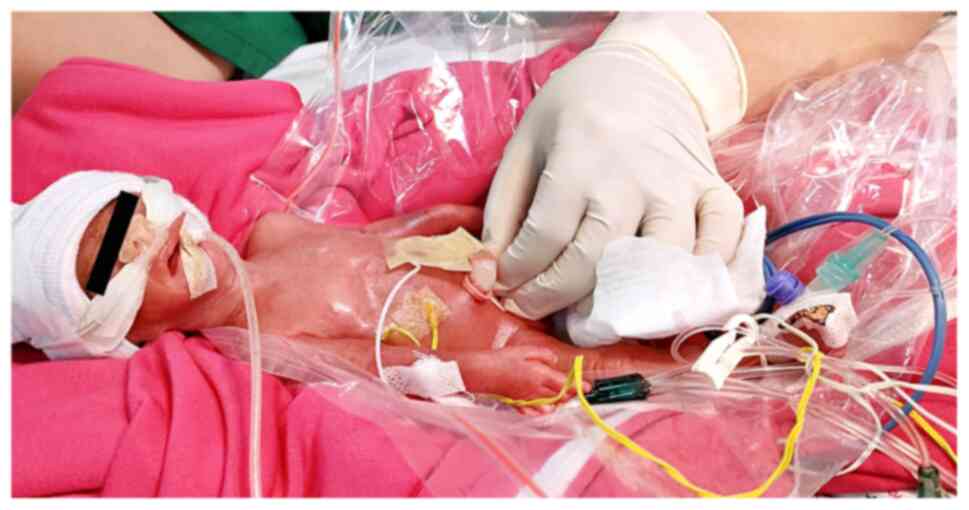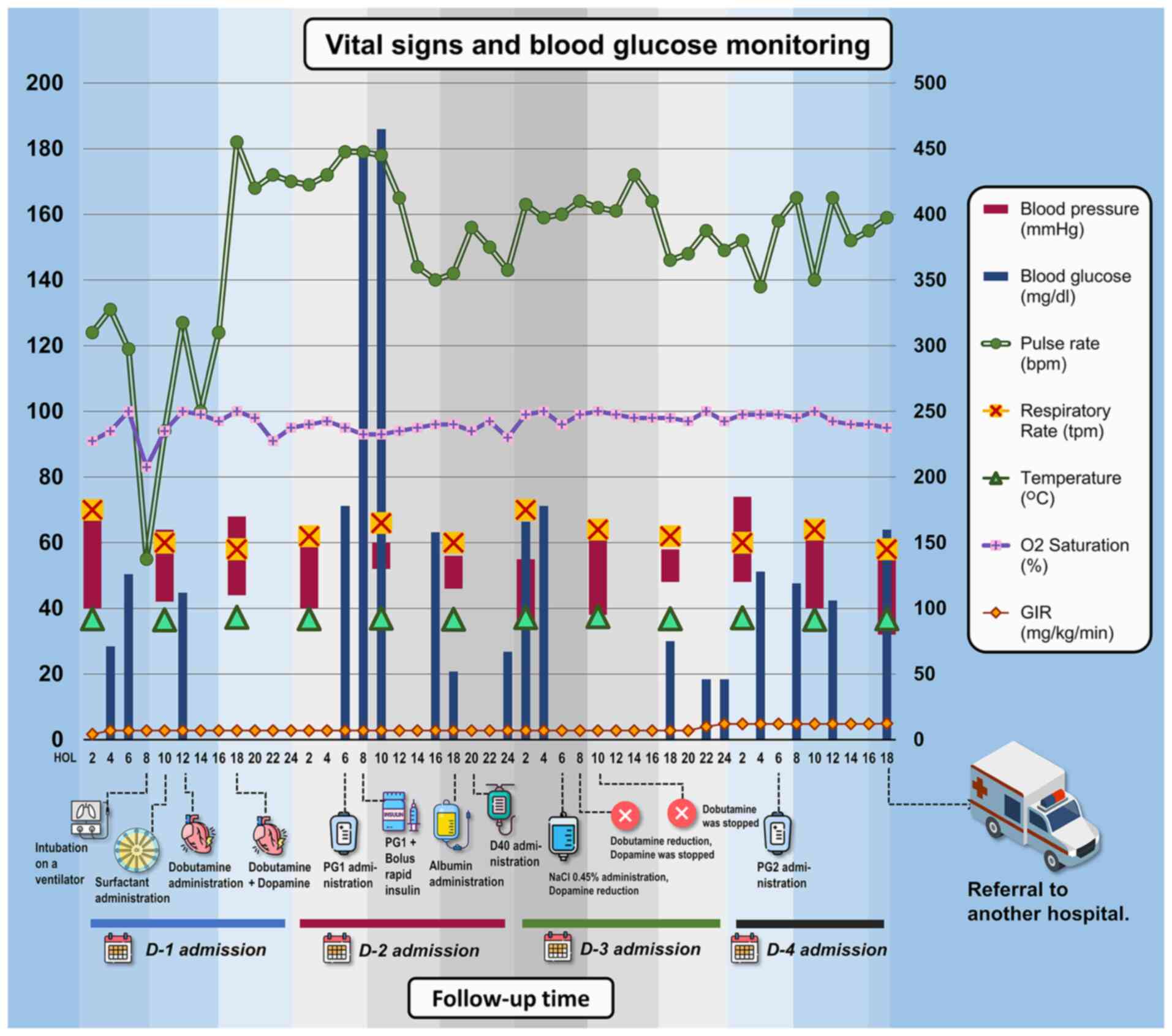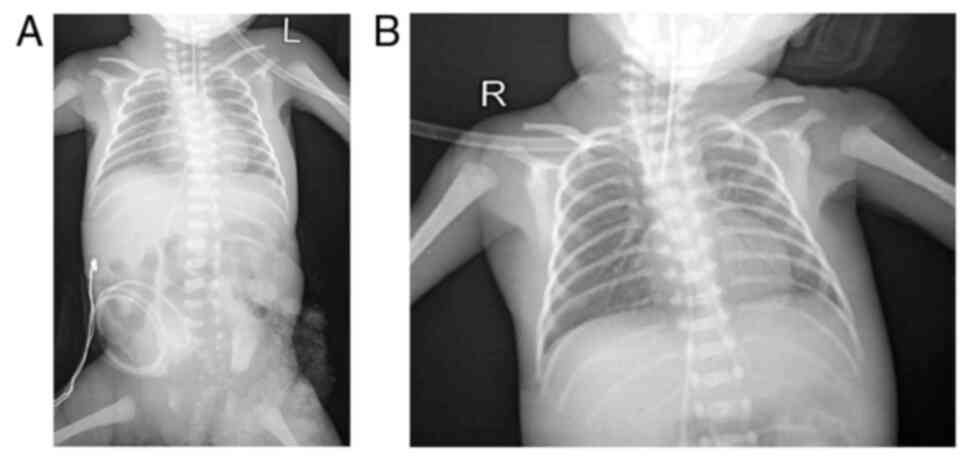|
1
|
Rath CP, Shivamallappa M, Muthusamy S, Rao
SC and Patole S: Outcomes of very preterm infants with neonatal
hyperglycaemia: A systematic review and meta-analysis. Arch Dis
Child Fetal Neonatal Ed. 107:269–280. 2022.PubMed/NCBI View Article : Google Scholar
|
|
2
|
Guiducci S, Meggiolaro L, Righetto A,
Piccoli M, Baraldi E and Galderisi A: Neonatal hyperglycemia and
neurodevelopmental outcomes in preterm infants: A review. Children
(Basel). 9(1541)2022.PubMed/NCBI View Article : Google Scholar
|
|
3
|
Ramel S and Rao R: Hyperglycaemia in
extremely preterm infants. Neoreviews. 21:e89–e97. 2020.PubMed/NCBI View Article : Google Scholar
|
|
4
|
Boscarino G, Conti MG, Gasparini C, Onestà
E, Faccioli F, Dito L, Regoli D, Spalice A, Parisi P and Terrin G:
Neonatal hyperglycemia related to parenteral nutrition affects
long-term neurodevelopment in preterm newborn: A prospective cohort
study. Nutrients. 13(1930)2021.PubMed/NCBI View Article : Google Scholar
|
|
5
|
El-Shimi MS, El-Saoud PMA and Ismail RIH:
Risk factors and outcomes of hyperglycaemia in low birth weight
infants: A prospective observational study. Egypt J Hosp Med.
89:6473–6479. 2022.
|
|
6
|
Zamir I, Stoltz Sjöström E, Ahlsson F,
Hansen-Pupp I, Serenius F and Domellöf M: Neonatal hyperglycaemia
is associated with worse neurodevelopmental outcomes in extremely
preterm infants. Arch Dis Child Fetal Neonatal Ed. 106:460–466.
2021.PubMed/NCBI View Article : Google Scholar
|
|
7
|
Gonzalez Villamizar JD, Haapala JL,
Scheurer JM, Rao R and Ramel SE: Relationships between early
nutrition, illness, and later outcomes among infants born preterm
with hyperglycemia. J Pediatr. 223:29–33.e2. 2020.PubMed/NCBI View Article : Google Scholar
|
|
8
|
Adeniji EO, Kuti BP and E Elusiyan JB:
Prevalence, risk factors, and outcome of hospitalization of
neonatal hyperglycemia at a Nigerian health facility. Niger J Clin
Pract. 23:71–78. 2020.PubMed/NCBI View Article : Google Scholar
|
|
9
|
Akmal DM, Razek ARAA, Musa N and El-Aziz
AGA: Incidence, risk factors and complications of hyperglycemia in
very low birth weight infants. Egypt Pediatr Assoc Gaz. 65:72–79.
2017.
|
|
10
|
Şimşek DG, Ecevit A, Hatipoğlu N, Çoban A,
Arısoy AE, Baş F, Mutlu GY, Bideci A and Özek E: Neonatal
hyperglycemia, which threshold value, diagnostic approach and
treatment?: Turkish neonatal and pediatric endocrinology and
diabetes societies consensus report. Turk Pediatri Ars. 53 (Suppl
1):S234–S238. 2018.PubMed/NCBI View Article : Google Scholar
|
|
11
|
Balasundaram P and Dumpa V: Neonatal
hyperglycaemia. In: Neonatal Hyperglycaemia or Name. Available
from: https://www.ncbi.nlm.nih.gov/books/NBK567769/.
Accessed September 1, 2023.
|
|
12
|
Parappil H, Gaffari M, Paramban R, Rijims
M, Skaria S and Ahmed SN: Management of hyperglycemia in the
neonatal unit A practical approach to diagnosis and management. J
Clin Neonatol. 11:38–44. 2022.
|
|
13
|
Kairamkonda VR and Khashu M: Controversies
in the management of hyperglycemia in the ELBW infant. Indian
Pediatr. 45:29–38. 2008.PubMed/NCBI
|
|
14
|
Beardsall K: Hyperglycaemia in the newborn
infant. Physiology verses pathology. Front Pediatr.
9(641306)2021.PubMed/NCBI View Article : Google Scholar
|
|
15
|
Ferguson IC: Neonatal hyperglycaemia: Case
report with plasma insulin studies. Arch Dis Child. 42:509–513.
1967.PubMed/NCBI View Article : Google Scholar
|
|
16
|
Hemachandra AH and Cowett RM: Neonatal
Hyperglycemia. Pediatr Rev. 20:e16–e24. 1999.
|
|
17
|
Yafi M: A case of neonatal diabetes
presentation, diagnosis and management. Austin J Pediatr.
1(1004)2014.
|
|
18
|
Manzar S: Glucose 250, MD notified: A case
report. SunKrist J Neonat Pediatr. 2(1012)2020.
|
|
19
|
Fargas-Berríos N, García-Fragoso L,
García-García I and Valcárcel M: Neonatal hyperglycemia due to
transient neonatal diabetes mellitus in puerto rico. Case Rep
Pediatr. 2015(984214)2015.PubMed/NCBI View Article : Google Scholar
|
|
20
|
Muzzy Williamson JD, Thurlow B, Mohamed
MW, Yokom D and Casas L: Neonatal hyperglycemia in a preterm infant
managed with a subcutaneous insulin pump. Am J Health Syst Pharm.
77:739–744. 2020.PubMed/NCBI View Article : Google Scholar
|
|
21
|
Gomella TL, Eyal FG and Bany-Mohammed F:
Gomella's Neonatology: Management, Procedures, On-Call Problems,
Diseases, and Drugs. 8th edition. McGraw Hill, New York, NY,
2020.
|
|
22
|
Consales A, Crippa BL, Colombo L, Villa R,
Menni F, Giavoli C, Mosca F and Bedeschi MF: CHARGE syndrome
presenting with persistent hypoglycemia: Case report and overview
of the main genetic syndromes associated with neonatal
hypoglycemia. Ital J Pediatr. 48(154)2022.PubMed/NCBI View Article : Google Scholar
|
|
23
|
Cromer SJ, Sella AC, Rosenberg E, Scully
K, McDonnell M, Abreu AP, Weil M, Bernstein SN, Quinn M, Powe C, et
al: Report of prolonged neonatal hypoglycemia in three infants of
mothers with variants in HNF1A. AACE Clin Case Rep. 8:224–230.
2022.PubMed/NCBI View Article : Google Scholar
|
|
24
|
Osada A, Arimitsu T, Kusakawa M, Kin T and
Hida M: A case of severe neonatal transient hyperinsulinemic
hypoglycaemia without identifiable risk factors: A case report. BMC
Pregnancy Childbirth. 22(423)2022.PubMed/NCBI View Article : Google Scholar
|
|
25
|
Rundjan L, Tirtaningrum Y and Anindita C:
Penanganan paripurna bayi prematur di ruang perawatan dalam
(comprehensive management of premature infants in the nursing
room). In: Panduan Pelayanan Kesehatan Anak Terpadu (Integrated
Child Health Care Guidelines). Trihono PP, Windiastuti E, Pardede
SO, Endyarni B and Alatas FS (eds). Faculty of Medicine University
of Indonesia, Department of Pediatric, Jakarta, pp18-28, 2013.
|
|
26
|
da Costa CS, Czosnyka M, Smielewski P and
Austin T: Optimal mean arterial blood pressure in extremely preterm
infants within the first 24 h of life. J Pediatr. 203:242–248.
2018.PubMed/NCBI View Article : Google Scholar
|
|
27
|
St Peter D, Gandy C and Hoffman SB:
Hypotension and adverse outcomes in prematurity: Comparing
definitions. Neonatology. 111:228–233. 2017.PubMed/NCBI View Article : Google Scholar
|
|
28
|
Mankoo PK, Shen R, Schultz N, Levine DA
and Sander C: Time to recurrence and survival in serous ovarian
tumors predicted from integrated genomic profiles. PLoS One.
6(e24709)2011.PubMed/NCBI View Article : Google Scholar
|
|
29
|
Kamarudin AN, Cox T and Kolamunnage-Dona
R: Time-dependent ROC curve analysis in medical research: Current
methods and applications. BMC Med Res Methodol.
17(53)2017.PubMed/NCBI View Article : Google Scholar
|
|
30
|
Utomo MT, Sumitro KR, Etika R and Widodo
ADW: Current-proven neonatal sepsis in Indonesian tertiary neonatal
intensive care unit: A hematological and microbiological profile.
Iran J Microbiol. 13:266–273. 2021.PubMed/NCBI View Article : Google Scholar
|
|
31
|
Cuzzolin L: Antibiotics and antifungals in
VLBW infants. J Pediatr Neonat Individual Med. 4(e040214)2015.
|
|
32
|
Lutsar I, Chazallon C, Trafojer U, de
Cabre VM, Auriti C, Bertaina C, Calo Carducci FI, Canpolat FE,
Esposito S, Fournier I, et al: Meropenem vs standard of care for
treatment of neonatal late onset sepsis (NeoMero1): A randomised
controlled trial. PLoS One. 15(e0229380)2020.PubMed/NCBI View Article : Google Scholar
|
|
33
|
Cao G, Zhou P, Zhang H, Sun B, Tong X and
Xing Y: Extended infusion of meropenem in neonatal sepsis: A
historical cohort study. Antibiotics (Basel).
11(341)2022.PubMed/NCBI View Article : Google Scholar
|
|
34
|
Binder ND, Raschko PK, Benda GI and
Reynolds JW: Insulin infusion with parenteral nutrition in
extremely low birth weight infants with hyperglycemia. J Pediatr.
114:273–280. 1989.PubMed/NCBI View Article : Google Scholar
|
|
35
|
Decaro MH and Vain NE: Hyperglycaemia in
preterm neonates: What to know, what to do. Early Hum Dev. 87
(Suppl 1):S19–S22. 2011.PubMed/NCBI View Article : Google Scholar
|
|
36
|
Hays SP, Smith EO and Sunehag AL:
Hyperglycemia is a risk factor for early death and morbidity in
extremely low birth-weight infants. Pediatrics. 118:1811–1818.
2006.PubMed/NCBI View Article : Google Scholar
|
|
37
|
Inage Y, Hirano D, Nakagawa A, Yamada S,
Kotake Y, Ikoma N, Kumazawa K, Hayashi S, Tanabe Y, Kobayashi M and
Shimizu M: Risk factors for hyperglycemia in extremely low birth
weight infants during the first 14 days. Pediatr Neonatol.
63:13–18. 2022.PubMed/NCBI View Article : Google Scholar
|
|
38
|
Wang J and Wang H: Oxidative stress in
pancreatic beta cell regeneration. Oxid Med Cell Longev.
2017(1930261)2017.PubMed/NCBI View Article : Google Scholar
|
|
39
|
Putri ND, Dickson B, Baker J, Adrizain R,
Kartina L, Sukarja D, Cathleen F, Husada D, Utomo M, Yuniati T, et
al: Epidemiology of Neonatal Sepsis in Indonesia: High burden of
multidrug-resistant infections reveals poor coverage provided by
currently-recommended neonatal sepsis treatment regimens. SSRN:
Preprints with the Lancet. Available from: https://dx.doi.org/10.2139/ssrn.4519552. Accessed
April 15, 2024.
|
|
40
|
Gul R, Waheed KAI, Sheikh M, Javaid S,
Haroon F and Fatima ST: Is hyperglycemia a risk factor for neonatal
morbidity and mortality? Pak Armed Forces Med J. 67:621–626.
2017.
|
|
41
|
van der Lugt NM, Smits-Wintjens VE, van
Zwieten PH and Walther FJ: Short and long term outcome of neonatal
hyperglycemia in very preterm infants: A retrospective follow-up
study. BMC Pediatr. 10(52)2010.PubMed/NCBI View Article : Google Scholar
|
|
42
|
Burattini I, Bellagamba MP, Spagnoli C,
D'Ascenzo R, Mazzoni N, Peretti A, Cogo PE and Carnielli VP: Marche
Neonatal Network. Targeting 2.5 versus 4 g/kg/day of amino acids
for extremely low birth weight infants: A randomized clinical
trial. J Pediatr. 163:1278–1282.e1. 2013.PubMed/NCBI View Article : Google Scholar
|
|
43
|
Zamir I, Stoltz Sjöström E, Edstedt Bonamy
AK, Mohlkert LA, Norman M and Domellöf M: Postnatal nutritional
intakes and hyperglycemia as determinants of blood pressure at 6.5
years of age in children born extremely preterm. Pediatr Res.
86:115–121. 2019.PubMed/NCBI View Article : Google Scholar
|
|
44
|
Stensvold HJ, Lang AM, Strommen K,
Abrahamsen TG, Ogland B, Pripp AH and Ronnestad AE: Strictly
controlled glucose infusion rates are associated with a reduced
risk of hyperglycaemia in extremely low birth weight preterm
infants. Acta Paediatr. 107:442–449. 2018.PubMed/NCBI View Article : Google Scholar
|
|
45
|
Tottman AC, Bloomfield FH, Cormack BE,
Harding JE, Mohd Slim MA, Weston AF and Alsweiler JM: Relationships
between early nutrition and blood glucose concentrations in very
preterm infants. J Pediatr Gastroenterol Nutr. 66:960–966.
2018.PubMed/NCBI View Article : Google Scholar
|
|
46
|
Burgess L, Morgan C, Mayes K and Tan M:
Plasma arginine levels and blood glucose control in very preterm
infants receiving 2 different parenteral nutrition regimens. JPEN J
Parenter Enteral Nutr. 38:243–253. 2014.PubMed/NCBI View Article : Google Scholar
|
|
47
|
Zamir I, Tornevi A, Abrahamsson T, Ahlsson
F, Engström E, Hallberg B, Hansen-Pupp I, Sjöström ES and Domellöf
M: Hyperglycemia in extremely preterm infants-insulin treatment,
mortality and nutrient intakes. J Pediatr. 200:104–110.e1.
2018.PubMed/NCBI View Article : Google Scholar
|
|
48
|
Sinclair JC, Bottino M and Cowett RM:
Interventions for prevention of neonatal hyperglycemia in very low
birth weight infants. Cochrane Database Syst Rev.
5(CD007615)2011.PubMed/NCBI View Article : Google Scholar
|
|
49
|
Beardsall K, Vanhaesebrouck S,
Ogilvy-Stuart AL, Vanhole C, Palmer CR, van Weissenbruch M, Midgley
P, Thompson M, Thio M, Cornette L, et al: Early insulin therapy in
very-low-birth-weight infants. N Engl J Med. 359:1873–1884.
2008.PubMed/NCBI View Article : Google Scholar
|
|
50
|
Alsweiler JM, Kuschel CA and Bloomfield
FH: Survey of the management of neonatal hyperglycaemia in
Australasia. J Paediatr Child Health. 43:632–635. 2007.PubMed/NCBI View Article : Google Scholar
|













